
Heavy to excessive rainfall is forecast over north Texas into Oklahoma Tuesday. Locally catastrophic flooding will be possible across portions of southwest Oklahoma. Flood Watches have been issued. Scattered severe thunderstorms are possible within a broad swath from the lower Great Lakes to the southern High Plains Tuesday afternoon into the evening. Read More >
Overview
An upper level trough approached the local area during the night of 5/26 and early morning of 5/27. At the surface, a weak cold front slowly approached from the west as ~1002mb low pressure tracked across the Great Lakes. A line of thunderstorms (well in advance of the cold front) was just to the west of the local area at 7 AM on 5/28. This line likely maintained its strength through the previous night given strong lift from robust height falls on the east side of the upper trough. The line of storms tracked across the area from west to east from the morning through early afternoon hours on 5/28. Strong to severe wind gusts and transient circulations accompanied the line of storms as it tracked across the area. In fact, a 50 knot (58 mph) wind gusts was recorded at Richmond International Airport as the line of storms passed through during the late morning. The environment was characterized by modest instability and relatively strong deep layer shear. Even though winds at the surface were S-SE, the lack of moderate to strong instability (as the line of storms crossed the area during the morning) and diurnal weakening of the 950-900 mb winds likely was enough to prevent tornadoes from forming. In addition, there was not a whole lot of directional wind shear from 0-1 km AGL. The atmosphere briefly stabilized after the line passed through, but partial clearing over western portions of the area allowed for instability to increase by late afternoon. 21z/5 PM manual surface analysis revealed a ~1007mb secondary triple point low centered over the south-central VA Piedmont, just ahead of the main cold front. Some localized backing of the surface wind field was observed as this secondary low tracked NNE during the evening hours. In addition, dew points increased to around 70F area-wide as the 950-850mb jet strengthened from 5 PM-8 PM (21-00z). This allowed for an increase in 0-1 km speed/directional shear, with low-level SRH values likely between 100 and 200 m2/s2. Given the aforementioned shear/instability, lowering LCLs, and presence of the triple point low, two of the storms were able to produce two tornadoes (one EF-1 and one EF-0) that resulted in tree and isolated structural damage in portions of Louisa/Hanover Counties. All severe weather came to an end by 10 PM.Tornadoes:
|
Tornado - Dabneys to Beaverdam
|
||||||||||||||||
|
Tornado - Yanceyville to 3 miles SSE of the Louisa Airport
Track Map 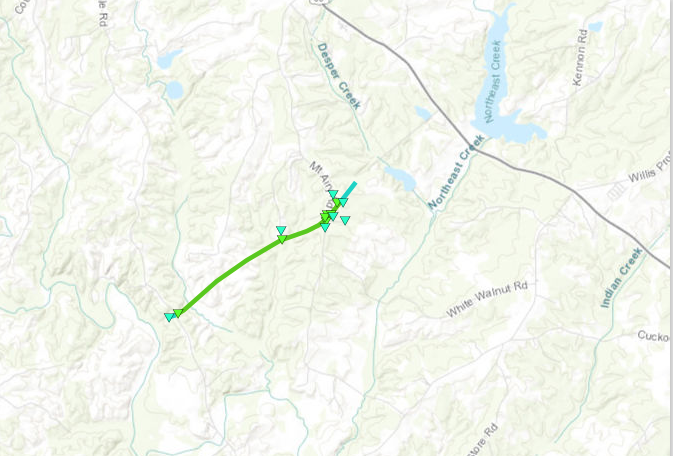 
|
||||||||||||||||
The Enhanced Fujita (EF) Scale classifies tornadoes into the following categories:
| EF0 Weak 65-85 mph |
EF1 Moderate 86-110 mph |
EF2 Significant 111-135 mph |
EF3 Severe 136-165 mph |
EF4 Extreme 166-200 mph |
EF5 Catastrophic 200+ mph |
 |
|||||
Photos
Selected Storm Damage Photos from Louisa County
 |
 |
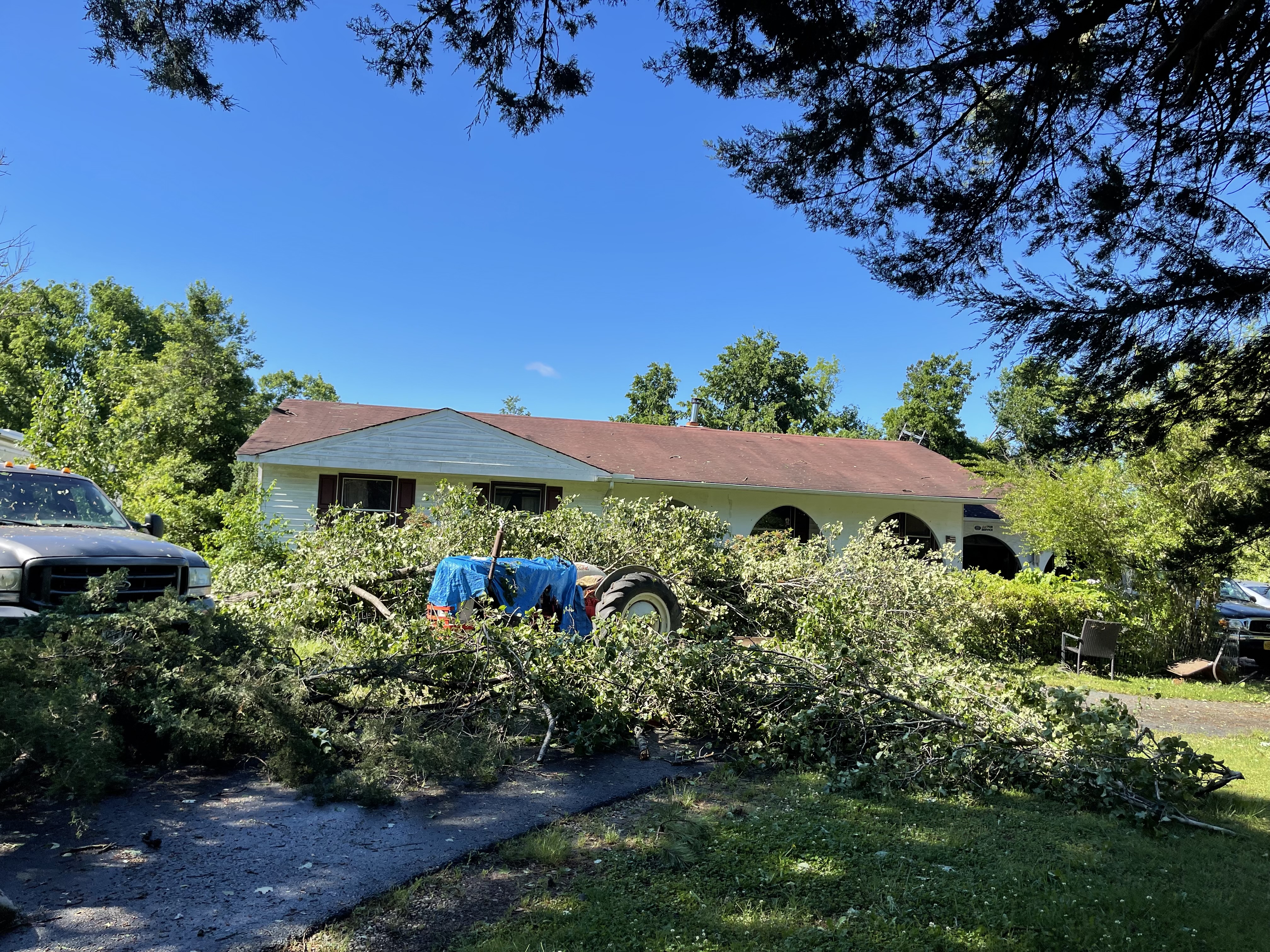 |
 |
| Credit: Angela Wesbey | Credit: Angela Wesbey | Credit: Angela Wesbey | Credit: Angela Wesbey |
Radar
Selected Radar Loops
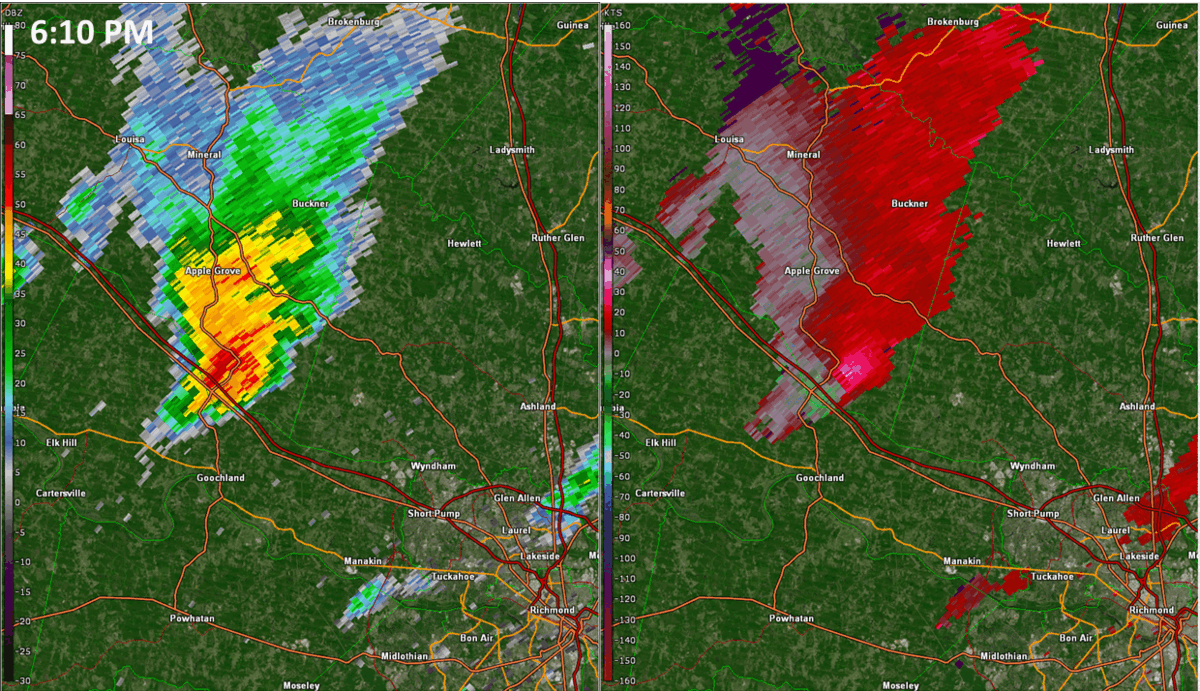 |
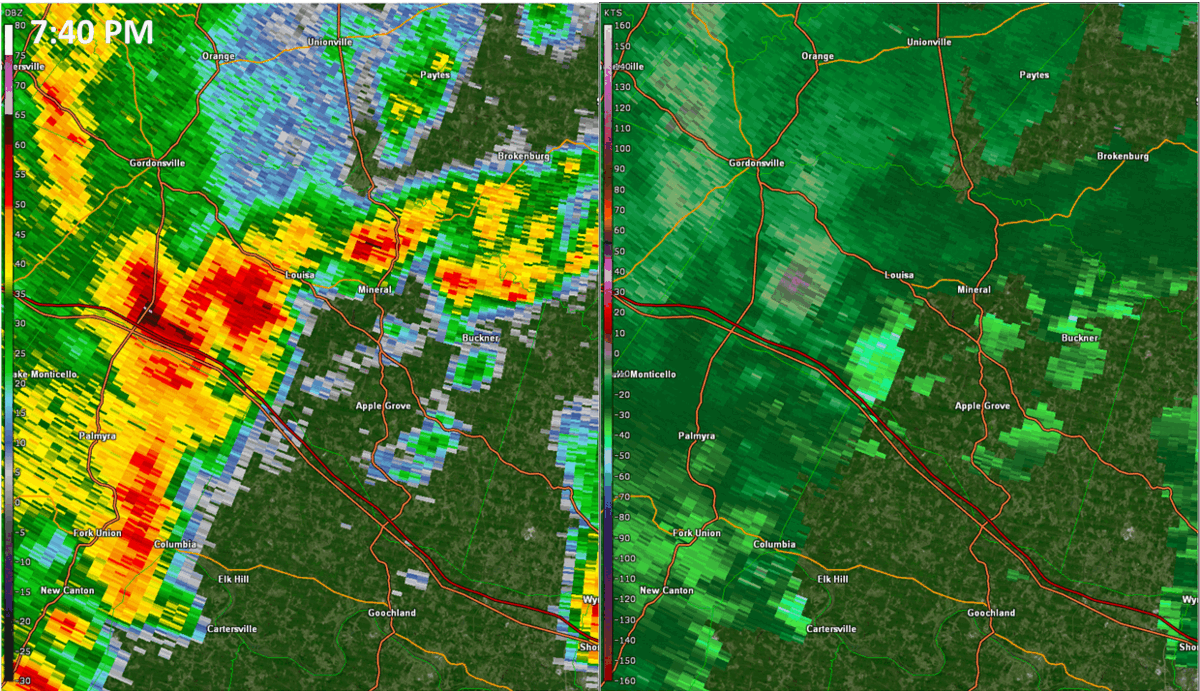 |
| Radar loop of KAKQ 0.5 degree reflectivity/base velocity from approximately 6-7 PM. Note that the rotation was fairly broad, and that the strongest rotation on radar appeared after the tornado had lifted. | Radar loop of KLWX 0.5 degree reflectivity/base velocity from approximately 735-8 PM, highlighting the other tornado producing storm that tracked across Louisa County. Note that the lowest volume scan available for this area is 6000-6500 ft AGL. In addition, the circulation that was associated with the EF-1 tornado was very short-lived. |
Storm Reports
0955 AM TSTM WND DMG 1 N TRENTS MILL 37.56N 78.29W
05/27/2022 CUMBERLAND VA UTILITY COMPANY
BROKEN UTILITY POLE. TIME ESTIMATED FROM
RADAR.
1027 AM TSTM WND DMG 1 SSW ELK HILL 37.70N 78.10W
05/27/2022 CUMBERLAND VA LAW ENFORCEMENT
MULTIPLE TREES DOWN ALONG AMPTHILL RD.
1059 AM TSTM WND DMG COLUMBIA 37.75N 78.16W
05/27/2022 CUMBERLAND VA LAW ENFORCEMENT
TREES DOWN NEAR COLUMBIA.
1135 AM TSTM WND DMG 1 ENE COLONIAL HEIGHTS 37.27N 77.38W
05/27/2022 CITY OF COLONIAL HEVA EMERGENCY MNGR
LARGE TREE FELL AND CRUSHED THE ROOF OF A
HOUSE.
1142 AM TSTM WND GST 1 N RICHMOND INTERNATIO 37.52N 77.32W
05/27/2022 M58 MPH HENRICO VA ASOS
ASOS STATION KRIC RICHMOND INTL AIRPORT.
1203 PM TSTM WND DMG 3 SE STUDLEY 37.65N 77.24W
05/27/2022 HANOVER VA DEPT OF HIGHWAYS
TREES DOWN.
1222 PM TSTM WND DMG 1 NE AHOSKIE 36.30N 76.98W
05/27/2022 HERTFORD NC PUBLIC
TREES AND LARGE LIMBS DOWN IN N AHOSKI.
1240 PM TSTM WND DMG GATES 36.50N 76.77W
05/27/2022 GATES NC PUBLIC
TREES AND LARGE DOWN NEAR GATES.
0124 PM MARINE TSTM WIND 1 WSW KIPTOPEKE STATE P 37.17N 75.99W
05/27/2022 M69 MPH NORTHAMPTON VA BUOY
BUOY STATION KPTV2 KIPTOPEKE, VA.
0135 PM TSTM WND DMG 3 W LINKWOOD 38.54N 76.00W
05/27/2022 DORCHESTER MD 911 CALL CENTER
TREE DOWN ON ROAD. TIME ESTIMATED FROM
RADAR.
0622 PM TORNADO 3 N DABNEYS 37.81N 77.80W
05/27/2022 LOUISA VA PUBLIC
TREES UPROOTED AND SNAPPED. LARGE CHICKEN
COOP THROWN APPROXIMATELY 100 YARDS.
POSSIBLE TORNADO. TIME ESTIMATED FROM RADAR.
0638 PM TORNADO 3 ENE MABELTON 37.86N 77.70W
05/27/2022 HANOVER VA EMERGENCY MNGR
BUILDINGS AND A HOME DAMAGED IN ADDITION TO
NUMEROUS TREES SNAPPED.
0641 PM TSTM WND DMG 1 NNE MABELTON 37.85N 77.74W
05/27/2022 HANOVER VA DEPT OF HIGHWAYS
CORRECTS PREVIOUS TSTM WND DMG REPORT FROM 1
NNE MABELTON. TREES REPORTS DOWN ALONG GUM
BARREL RD, MABELTON RD AND PEASANT HILL RD.
0654 PM TSTM WND DMG 1 NW CEDAR FORK 37.98N 77.57W
05/27/2022 CAROLINE VA 911 CALL CENTER
REPORT OF MULTIPLE TREES AND POWER LINES
DOWN IN THE JERICHO ROAD AREA. DAMAGE MAY BE
DUE TO POSSIBLE TORNADO. TIME ESTIMATED FROM
RADAR.
0703 PM TSTM WND DMG FLAT ROCK 37.52N 77.82W
05/27/2022 POWHATAN VA NWS EMPLOYEE
TREES DOWN ALONG HIGHWAY 60.
0715 PM TSTM WND DMG 2 NNW WILMINGTON 37.88N 78.22W
05/27/2022 FLUVANNA VA 911 CALL CENTER
TREE DOWN ON ROAD NEAR GEORGES MILL ROAD AND
RISING SUN ROAD.
0737 PM TSTM WND DMG 2 W PORT ROYAL 38.17N 77.22W
05/27/2022 CAROLINE VA DEPT OF HIGHWAYS
TREES DOWN.
0754 PM TSTM WND DMG 3 S LOUISA AIRPORT 37.97N 77.97W
05/27/2022 LOUISA VA LAW ENFORCEMENT
POWER POLE BROKEN AND SHEDS TIPPED OVER AT
THE END OF WESTBY DR. POSSIBLE TORNADO.
0755 PM TSTM WND DMG 3 SSE LOUISA AIRPORT 37.97N 77.96W
05/27/2022 LOUISA VA BROADCAST MEDIA
PICTURES OF TREES SNAPPED ALONG MT. AIRY
ROAD. POSSIBLE TORNADO.
0800 PM TSTM WND DMG 1 NNE YANCEYVILLE 37.94N 77.98W
05/27/2022 LOUISA VA 911 CALL CENTER
REPORTS OF MULTIPLE TREES DOWN IN THE
YANCEYVILLE ROAD AND MOUNT AIRY ROAD AREA.
Environment
Synoptic Summary.
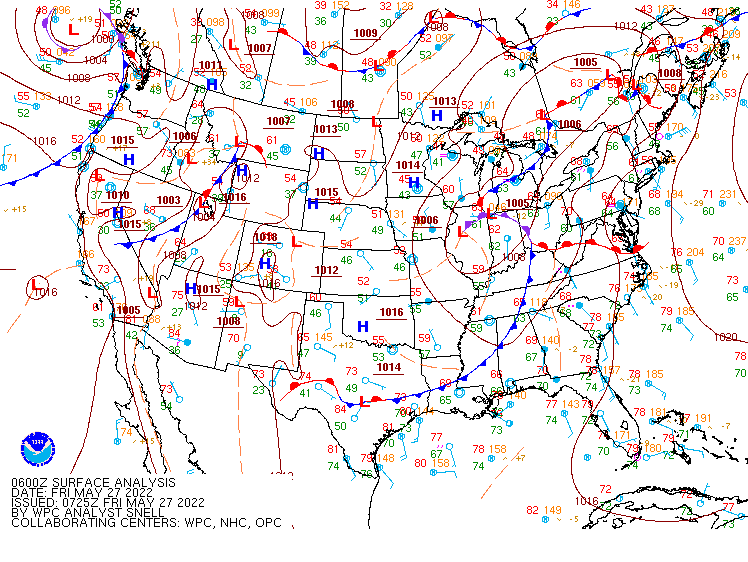 |
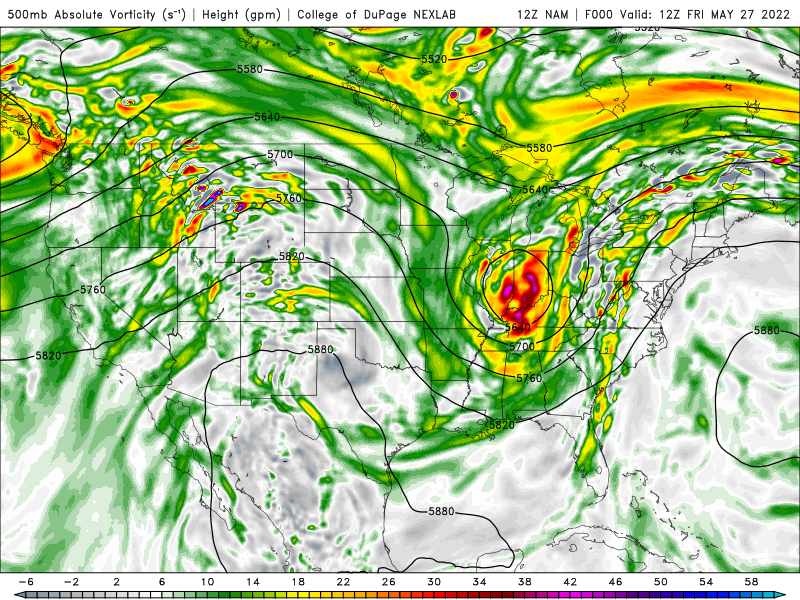 |
| Loop of WPC Surface Analysis from 06z/2 AM on 5-27 to 12z/8 AM on 5-28 | Loop of 12z/27 NAM Forecast 500mb Heights/Vorticity from 8 AM to 8 PM on 5/27 |
Selected Regional Mesoanalysis/Observation Data.
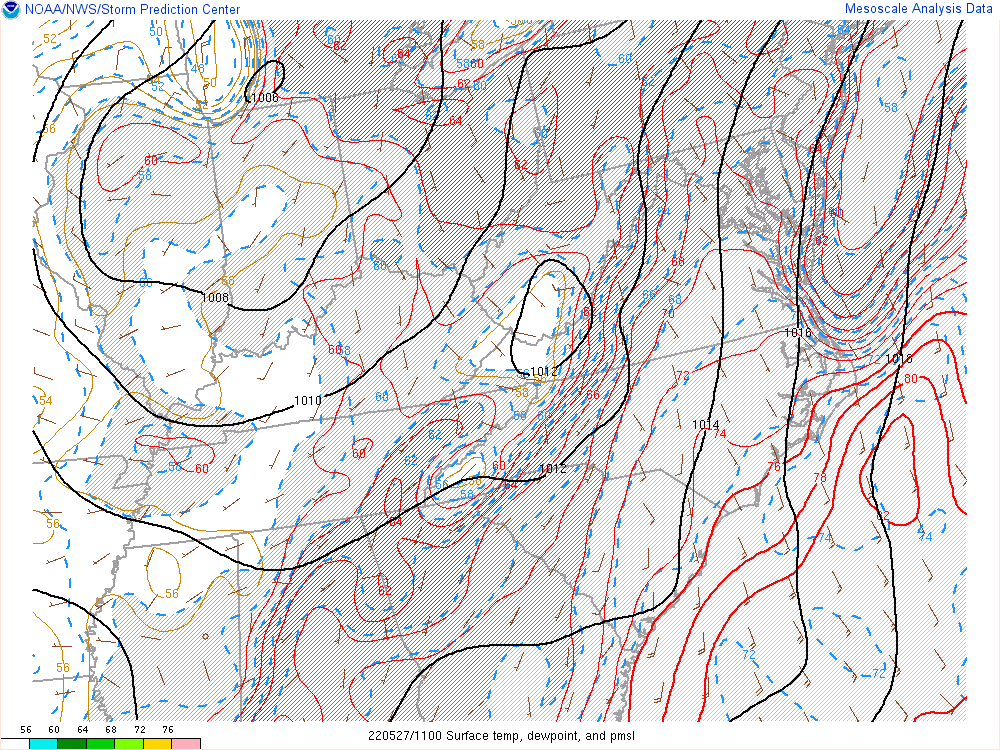 |
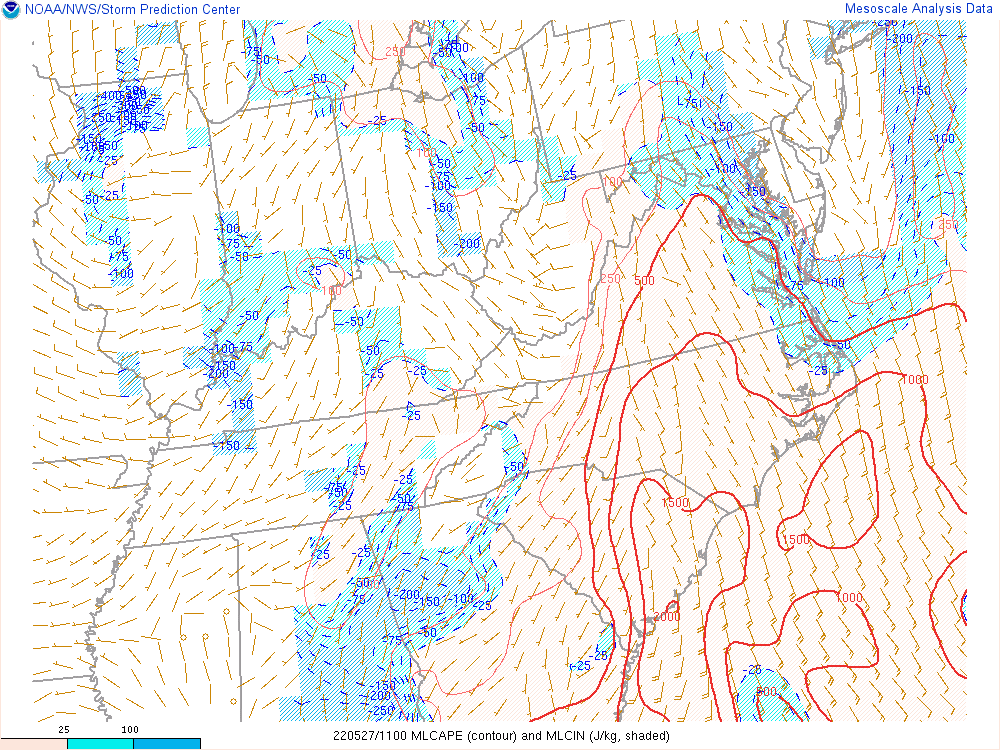 |
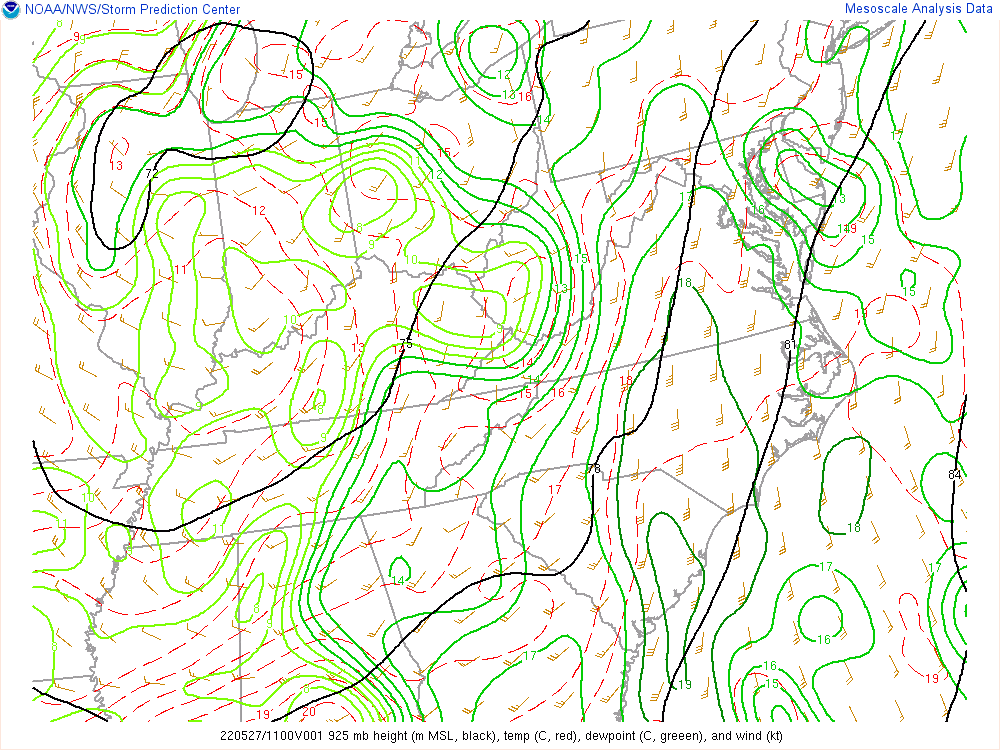 |
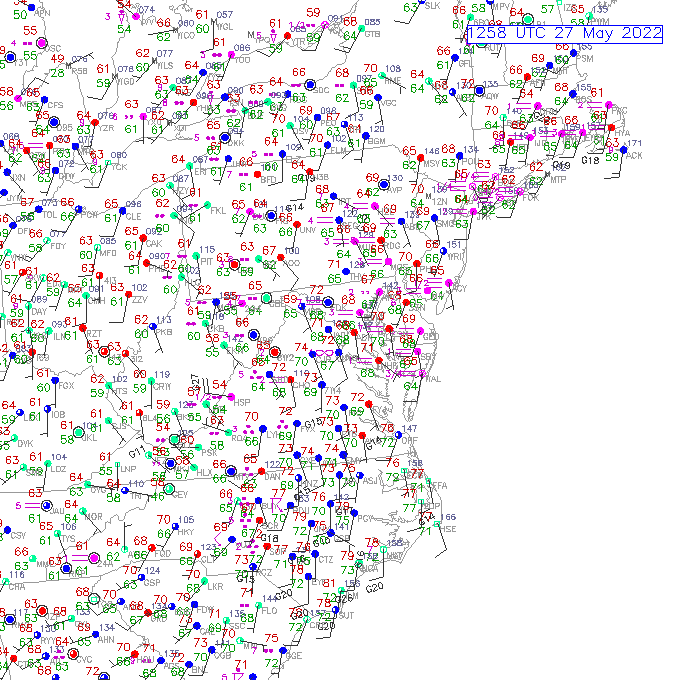 |
| Loop of T/Td/MSLP/Wind from 8 AM to 9 PM on 5/27 | Loop of MLCAPE/MLCIN from 8 AM to 9 PM on 5/27 | Loop of 925mb Analysis from 8 AM to 9 PM on 5/27 | Loop of Regional Observations from 8 AM to 9 PM on 5/27 |
Selected Near Storm Soundings.
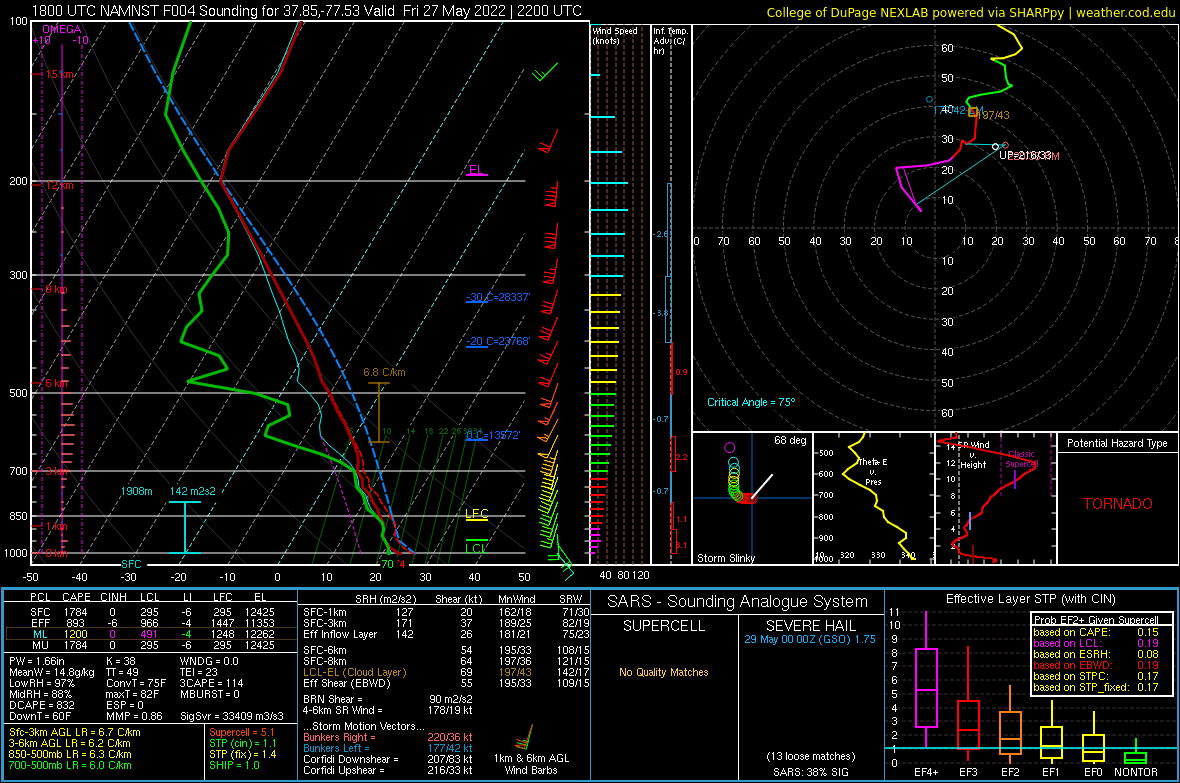 |
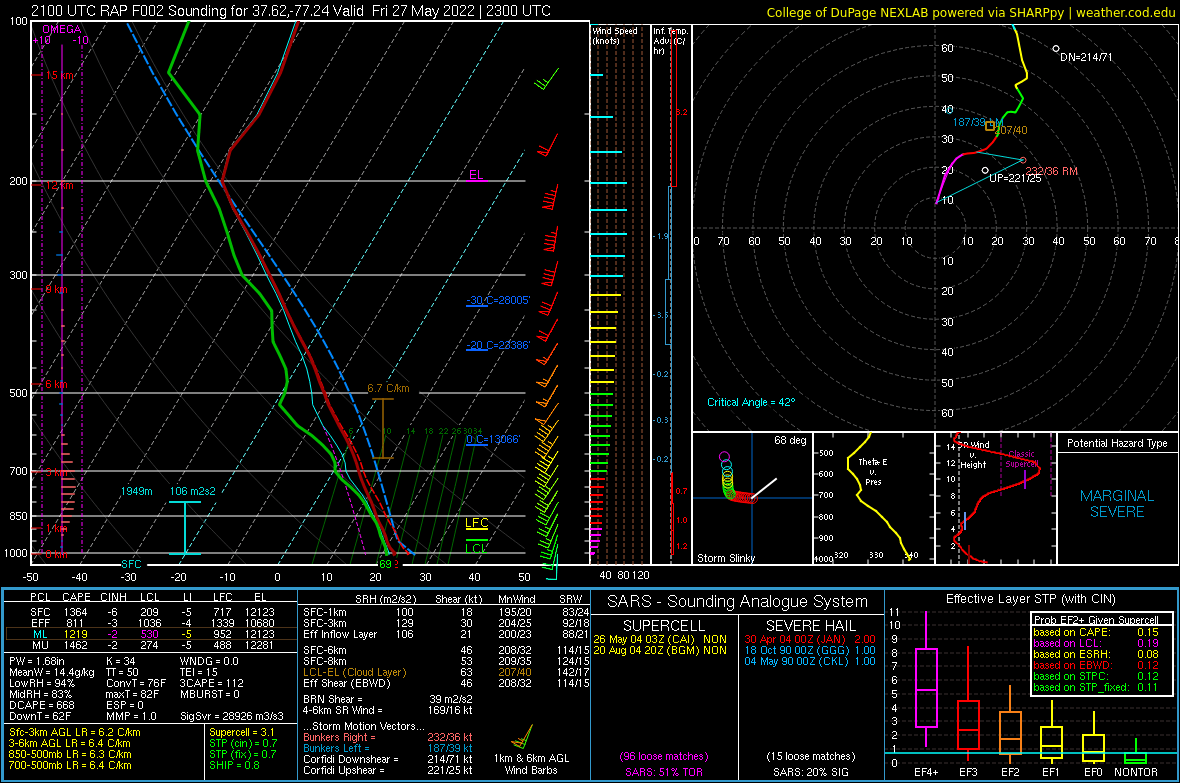 |
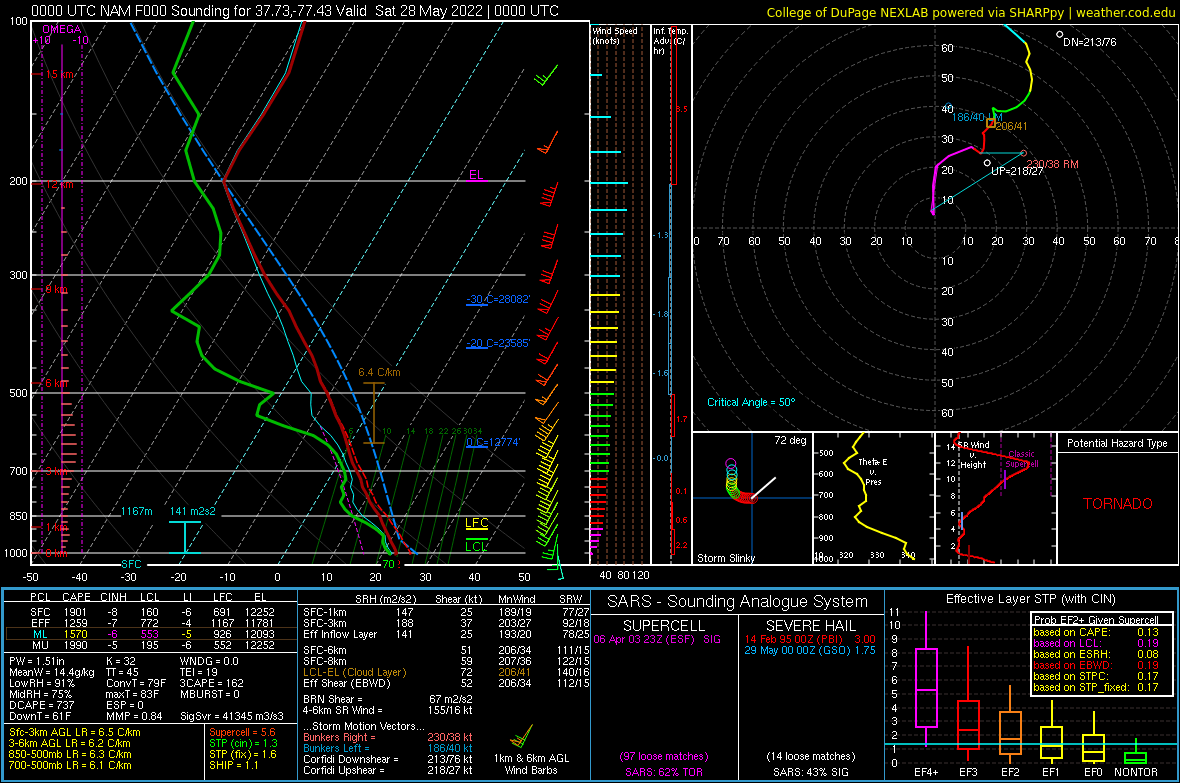 |
| 22z NAMNest Sounding near KOFP | 23z RAP Sounding near KOFP | 00z NAM Analysis Sounding near KOFP |
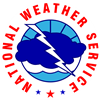 |
Media use of NWS Web News Stories is encouraged! Please acknowledge the NWS as the source of any news information accessed from this site. |
 |